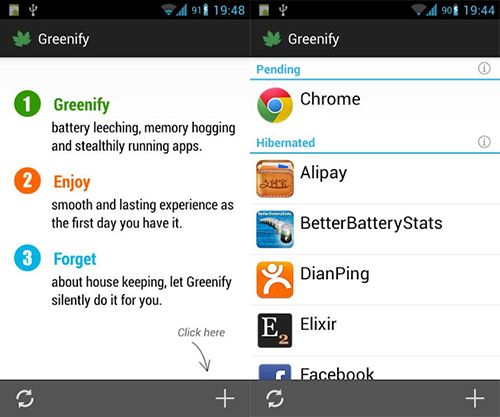There are instances when you load your device with various different applications rendering the internal and external memory relatively full. That slows down the functionality of your cellphone. Another drawback of these instances is that the battery is eaten rather quickly. Where iPhone users do not experience (or none that we know of) any such symptoms, android users complain of this quite often. There is an application that you can use to get rid of slow functioning after heavy application loading and it’s called Greenify.

This particular application can help identify which application might be causing these symptoms in the background and it puts the application into hibernation when you are not using them. That saves battery and that also allows your device to run smoothly as it would under normal circumstances. These applications would not run again unless of course you open the application itself. One thing you should know is that the application requires your device to be rooted. There are many applications that offer similar functionality but according to the original thread over at the XDA, this is how Greenify differs:
- Unlike the “Freeze” feature in “TitaniumBackup Pro” that totally disables your app, you can still use your app as usual, share content with it, without major uncomfortable impact on user experience. Greenify is nearly transparent! Set and forget.
- Unlike “App Quarantine”, you can launch greenified apps in any way as usual. No more crafted app-launch widgets, no more manual disabling.
- Unlike “Autostarts”, you can benefit almost all its advantages, but never need to deal with the complexity and risk of obscurely named app components, and never lose functionality when app is actively running.
- Unlike any “XXX Task Killer“, your device never falls into the cat-mouse-game of stealthy-running and aggressive killing, which unnecessarily consumes much battery juice. Since all greenified apps will be put into hibernation until the next time you launch them, there is no need to “kill” them during the hibernation.
Following is how the application functions in the background:
- Persistent background services
- Broadcast receivers, which respond to global device events, such as network state change, SMS reception.
- Alarms, which activate background task at specific time or interval.
- Widget update. Widget should display but never update because periodic update involves background task.
- Push messages. Push is also disabled since it would activate background task on Android, unlike iOS which just shows up messages to user.
The application is available for free at the Google Play Store and is compatible with devices running Android 3.1 and higher. Download it, play with it and let us know how it functions and what you think.